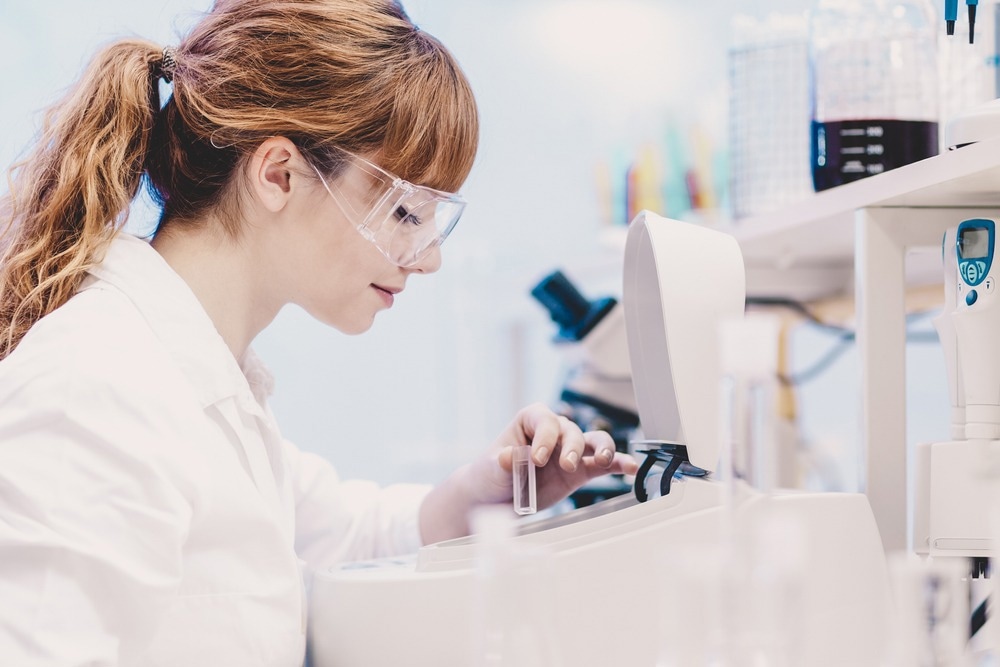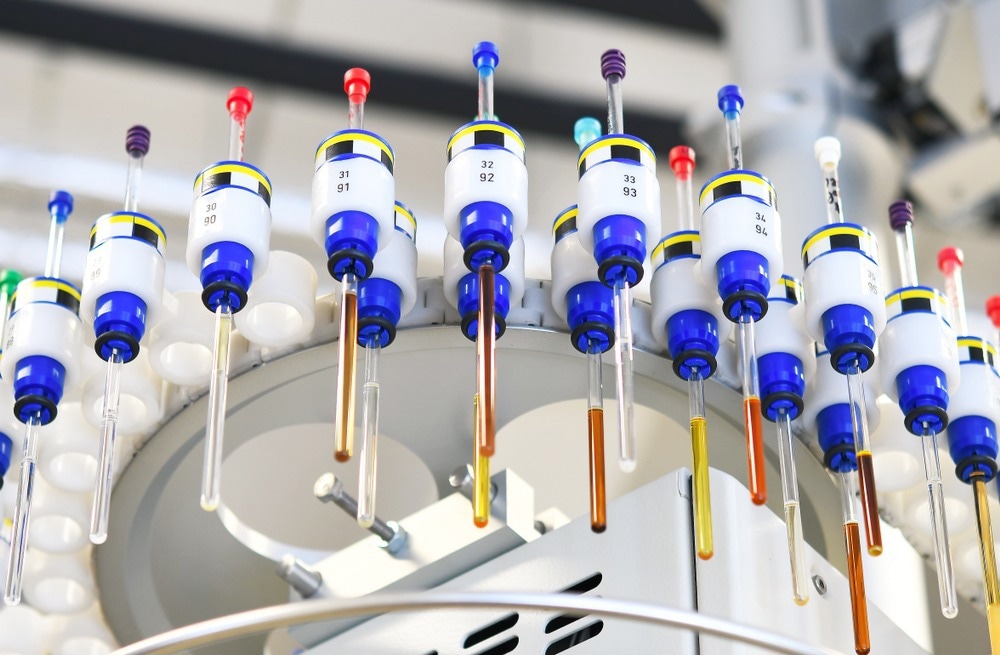Spectrophotometry uses spectrophotometers (photometers) to measure light intensity at varied wavelengths. A spectrophotometer is an analytical instrument used to measure a material's optical properties based on the intensity of wavelengths in a particular spectrum of light, i.e., from the ultraviolet to the visible and infrared spectral (IR) region. Spectrophotometry assumes that each chemical element has its own spectrum. Spectrophotometers measure light intensity as a function of the wavelengths of the light source.

Image Credit: Matej Kastelic/Shutterstock.com
History of Spectrophotometry
Dr. Arnold J. Beckman and his colleagues at the National Technologies Laboratories first invented the spectrophotometer in 1940. In 1935 Beckman founded the company, and the discovery of the spectrophotometer was their most ground-breaking invention. Dr. Bruce Merrifield, a Nobel prize-winning biochemist, stated that the invention of the spectrophotometer was "probably the most important instrument ever developed towards the advancement of bioscience."
Before the discovery of the spectrophotometer, chemical analyses took weeks to complete, with 25% accuracy. After introducing the Beckman DU Spectrophotometer, chemical analysis was simplified, and results were generated within a few minutes with 99.99% accuracy.
Over time, scientists kept improving the spectrophotometer design to enhance its performance. For instance, the UV capabilities of the model B spectrophotometer were improved by replacing the glass prism with a quartz prism. Eventually, the Model DU was created, containing a hydrogen lamp and other improvements. This instrument was used in industrial laboratories, clinics, and chemistry and biochemistry departments.
Cecil Instruments created a microprocessor-based spectrophotometer, which automated and improved the device's processing speed. After 1984, double-beam versions of the device were designed. The addition of external software with the provision of onscreen displays of the spectra came in the 1990s.
Working Principle of Spectrophotometer
Generally, a spectrophotometer is made up of two instruments, namely, a spectrometer and a photometer. A basic spectrophotometer contains a light source, a monochromator, a collimator for straight light beam transmission, a cuvette to place a sample, and a photoelectric detector. The spectrophotometer can be operated in the UV region, visible spectrum, and IR spectrum. There are different types of spectrophotometers in various shapes and sizes, each with its own purpose or functionality.
A spectrophotometer determines how much light is reflected by chemical components. It measures the difference in light intensity based on the total amount of light introduced to a sample and the amount of light beam that passes through the sample solution. The main working principle of a spectrophotometer is that each compound absorbs or emits light over a certain wavelength spectrum.
As per the instrument's design, the sample is placed between the spectrometer and the photometer. After the light is passed through the sample, the photometer measures its intensity and displays the reading.
Different Types of Spectrophotometers and their Applications
A spectrophotometer is used to determine the concentration of both colorless and colored solutes in a solution. This instrument is used to determine the rate of a reaction. Different types of spectrophotometers are used in academic and commercial industries, such as forensics, pharma, agriculture, medicine, food, and paint. For example, blood is analyzed using a spectrophotometer to detect metallic deficiencies.
Forensics use UV-vis and IR spectrophotometers to study evidence collected from the crime site, such as minute amounts of textiles, hair, or oil. Spectrophotometry is also used to identify cosmetics, pesticides, drugs, and fungal spores.
Farmers use a spectrophotometer to analyze the ripeness of fresh produce, the moisture content of grains, meat tenderness, and the quality of milk. It also checks the chemical content and origin of raw materials, such as cocoa for chocolates, honey, and olives for oil.
Distributors often use a spectrophotometer to assess the quality of flour, coffee, and other products, which is important for storage and distribution. This analysis also helps predict product profit/loss. Restaurants and retailers analyze water, agriculture, and dairy products to understand the quality and shelf-life of agricultural produce. Thereby, a spectrophotometer is used in various industries for quality assessment and correct labeling.
In the aerospace industry, chemical, oil, and gas industries, spectrophotometry is used to understand the reason behind a product/process failure. For instance, aluminum alloys are used as a structural component of aerospace, and spectrophotometry is used to detect weakness or fault in structure. The paint and cement industry use UV-vis spectrophotometers for quality control.

Image Credit: masa44/Shutterstock.com
Some of the important types of spectrophotometers that are commonly used in various industries are discussed below:
Visible Light Spectrophotometer:
This type of spectrophotometer uses visible light from a tungsten lamp. It is commonly used in routine laboratory work. Two types of visible light spectrophotometer models are available: portable and bench-top.
UV/Visible Spectrophotometer:
This type of spectrophotometer uses a light source to illuminate a sample with light across the UV to the visible wavelength range. It can detect up to 1100 nm and consists of many features, such as a scanning function, multiple cell settings, a user interface, and an integral printer.
The pharma industry commonly uses this technique to determine drug concentration (e.g., etravirine). In addition, it helps assess the vaporization of low-volatile compounds. Importantly, a UV/visible spectrophotometer is used to ascertain sample purity. Many biochemical laboratories use this instrument (e.g., Multiskan SkyHigh Microplate Spectrophotometer by Thermo Fisher) to evaluate micromolar concentrations of substances in the urine, blood, and other body fluids.
Infrared (IR) Spectrophotometer:
Although the working of this spectrophotometer is similar to a UV spectrophotometer, it measures a sample's response when exposed to IR light. One of the key advantages of this tool is the simple sample preparation method. Typically, an IR-based spectrophotometer is used to identify chemical compounds and functional groups in organic molecules, such as aliphatic, aromatic, saturated, and unsaturated hydrocarbons, halogens, silicon, and hydroxyl groups. In addition, it is used to study enzymatic reactions and molecular interactions.
Fourier transform infrared spectrophotometer (e.g., IRTracer-100 by Shimadzu) is a powerful analytical tool used to determine chemical constituents and elucidate their structures in various forms in real-world samples. Near IR (NIR) spectrophotometer is used to study fat, protein, fiber, and starch content. Recently, scientists have been using the CI-710s SpectraVue Leaf Spectrometer (NIR spectrophotometer) to study many physiological processes and detect stress in plants
Nuclear Magnetic Resonance (NMR) Spectrophotometry:
NMR is an extremely important analytical technique for metabolic research. It is also used to study intact biological specimens, such as kidneys, hearts, and skeletal muscles, using the 31P isotope. This type of spectroscopy is used to determine the structure of organic compounds. Notably, this device provides a sample's structural details and dynamic information on organic reactions. NMR spectrophotometry is used to identify novel compounds.

Image Credit: smereka/Shutterstock.com
Raman Spectrophotometer:
Raman spectroscopy is based on the scattering of light, known as the Raman effect. When monochromatic light is exposed to a sample, it scatters in all directions, measured by a detector. This type of spectrophotometer (e.g., Ramina Process Analyzer by Thermo Fisher) is commonly used in cell therapy development and molecular diagnosis of cervical cancer. Besides medical utilization, the Raman spectrophotometer is also used in agriculture, particularly for the early detection of plant diseases.
Atomic Absorption Spectrophotometer (AAS):
AAS (e.g., iCE 3500 AAS Atomic Absorption Spectrometer by Thermo Fisher) is commonly used for quantitative analysis, such as estimating metals in body fluids for clinical assessment. This high-precision analytical technique is used in toxicology, quality control laboratories, and environmental testing. AAS is also used to determine food and water quality.
Mercury Spectrophotometer:
This type of spectrophotometer is used to detect trace amounts of mercury in water.
Current Global Scenario of Spectrophotometer
The spectrophotometer market size is projected to reach multimillion USD by 2028. The UV-Visible spectrometry market is expected to reach USD 1.88 billion by 2030. Although many companies produce different spectrophotometers, some key manufacturers are Agilent Technologies, Thermo Fisher Scientific Inc., Hitachi, Shimadzu Corporation, PerkinElmer, and Beckman Coulter.
Of all the molecular strategies, NMR spectrophotometry, followed by IR spectrophotometry, are most widely used in the pharma industry and academic research. Recently, researchers at Aalto University have designed a miniaturized spectrophotometer onto a single chip, which can analyze any wavelength of visible light and part of the infrared spectrum. This small portable device can operate at ambient temperatures.
Shimadzu has also recently launched a new AAS, AA-7800 Series, which is highly sensitive, stable, versatile, and supports multielement analysis. It contains double beam optics to ensure reliable data acquisition. The utilization of an advanced spectrophotometer will expedite research output significantly.
Sources:
- Businesswire. (2023) 'In-line UV-vis Spectroscopy Market Size, Share & Trends Analysis Report 2022: Pharmaceutical/Chemical - Global Forecast to 2030 - ResearchAndMarkets.com'. Available at: www.businesswire.com/.../...-Forecast-to-2030---ResearchAndMarkets.com. (Accessed: 24 January 2023).
- Laboratory Info. (2022) 'Spectrophotometer – Principle, Types, Uses and Applications'. Available at: https://laboratoryinfo.com/spectrophotometer/. (Accessed: 24 January 2023).
- Dadi, M. and Yasir, M. (2022) ‘Spectroscopy and Spectrophotometry: Principles and Applications for Colorimetric and Related Other Analysis. Colorimetry’. IntechOpen. DOI: 10.5772/intechopen.101106.
- Kaye, H. et al. (2022) 'Application of Spectrophotometry in a Non-Invasive Way of Measuring Creatinine Levels. In 2022 11th International Conference on Software and Computer Applications (ICSCA 2022)'. Association for Computing Machinery, New York, NY, USA, pp.185–190. https://doi.org/10.1145/3524304.3524331. (Accessed: 24 January 2023).
- Oldach, L. (2022) 'Smallest-yet spectrophotometer works at room temperature'. Available at: https://cen.acs.org/analytical-chemistry/spectroscopy/Smallest-yet-spectrophotometer-works-room/100/web/2022/11. (Accessed: 24 January 2023).
- Yoon,H.H. et al. (2022) 'Miniaturized spectrometers with a tunable van der Waals junction', Science, 378(6617), pp. 296-299.
- DOI: 10.1126/science.add8544
- Shimadzu. (2022) 'New Atomic Absorption Spectrophotometers Provide High-Sensitivity Analysis'. Available at: https://www.labmanager.com/product-news/new-atomic-absorption-spectrophotometers-provide-high-sensitivity-analysis-28936. (Accessed: 24 January 2023).
- Gaughan, R. (2017) 'How to Measure an LED's Brightness'. Sciencing. Available at: https://sciencing.com/measure-leds-brightness-8387307.html. (Accessed: 24 January 2023).
- Nasrazadani, S. and Hassani, S. (2016) 'Modern analytical techniques in failure analysis of aerospace, chemical, and oil and gas industries'. Handbook of Materials Failure Analysis with Case Studies from the Oil and Gas Industry.
Further Reading
Last Updated: Apr 3, 2023